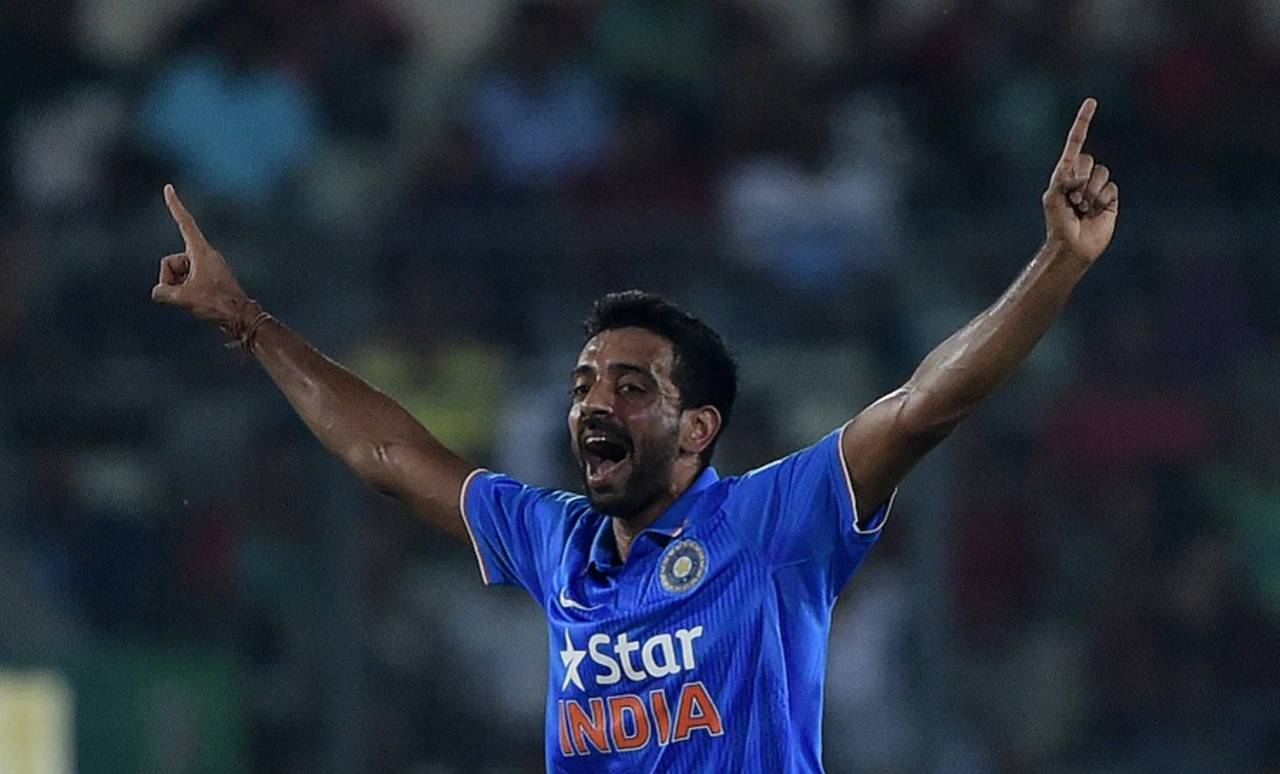Dhawal Kulkarni's career has been a bit of a roller coaster ride. He was fast-tracked into the Indian team as a 20-year old in 2009, and soon found himself in the wilderness without getting a game. If you were to run through a list of injuries he has suffered since, it is likely he has ticked most modern-day injuries associated with fast bowlers - hamstring, ankle, side strain, knee and groin.
If you have not seen Kulkarni bowl, it is unlikely you will mistake him for a medium-pacer. There is always a smile on his face that masks the disappointment. He is apologetic, most times, in his demeanor on and off the field, and does not have looks that can intimidate. But when you see him hare across the turf, sprint with the energy of a fast bowler who is conditioned to sustain the modern-day rigours, the other side of him surfaces.
When Kulkarni first burst onto the scene, he was no more than a skiddy bowler. On surfaces that lacked bite, he was deemed largely as a containing option. Bowling alongside Zaheer Khan and Ajit Agarkar at the nascent stage of his career meant he was mostly pressed into service when a bulk of the damage was already done or when he had to give the strike bowlers a breather.
All that seems to have changed now. At 27, Kulkarni is no spring chicken. He is the undisputed leader of Mumbai's seam attack, even though Shardul Thakur has looked more potent of the two at various stages this season. With 12 wickets in seven games spread across three stints because of constant niggles, Kulkarni's form and fitness were in question, even if there was not an immediate threat to his place in the XI. Despite having missed the semi-final against Madhya Pradesh, there was a sense of anticipation when the team management waited on his fitness before naming their XI for the final.
On Wednesday, the sprightly side of him surfaced as he used a green Pune surface as an ally to clinically dismantle Saurashtra's top order. His figures of 4 for 30 after 18.4 overs of toil was reward for his discipline, for most parts; the nagging length, the late swing with the new ball and the extra dimension in his repertoire through a few extra yards of pace all came together to give Mumbai the edge in the Ranji Trophy final.
"It did a bit in the first session, and then the surface eased out considerably, so it was important to stem the flow of runs," Kulkarni said "That's what (Abhishek) Nayar and Ballu (Balwinder Sandhu) did. Till around 20 overs, the ball did a bit off the surface, but later on it became easy if the batsmen applied themselves."
Even though it later became easy to hit the ball through the line, there was also a small matter of the batsmen not being offered freebies, which was the case for most parts of the day. Watching Kulkarni bowl with the new ball was a throwback to January 2013, when he scythed through Saurashtra to pick up a nine-wicket haul that helped Mumbai win their 40th title. From then to now, Kulkarni's evolution as a senior statesman in a side that has been in a rebuilding phase has been important.
"There was always responsibility on my shoulders since I started playing for Mumbai," Kulkarni countered, when asked to explain his role in the Mumbai setup over the years. "I was never at ease when I wanted to bowl for Mumbai. The responsibilities that you have, it makes you feel really proud. Being the senior-most bowler in this team is something I really enjoy."
Leading a young attack has somewhat completed his transformation. The proof lays in the manner in which he plotted Cheteshwar Pujara's dismissal. After bowling a succession of in-swingers that had Pujara searching for deliveries outside the line, he cleverly varied his angle and nipped one away. Pujara was up to the task as he drove one handsomely past mid-off to collect his first boundary.
He then removed mid-off to and brought in a close-in fielder who was in Pujara's eyeline. By once again bowling a similar line, he drew Pujara forward, except the length was held back ever-so-slightly. Within the bat of an eyelid, the edge was found and Saurashtra's most-prolific batsman was walking back shaking his head vehemently in disappointment.
"Pujara is always a little dicey on the ball which comes in and that's what I had in my mind," he said. I have played against him before as well, so that's what was there in my mind, to keep bowling it in and then surprise him with the outgoing delivery."
Kulkarni attributed his success to a combination of factors. While he admitted to being "disappointed" at spending time on the India bench without getting game time for most parts of the season gone by, he was not "disheartened", for the prospect of bowling to some of the most feared white-ball strikers in the Indian team egged him on.
"I just took (the snub) it in a positive way," he said. "I learnt a lot. I kept bowling in the nets. I practiced on my skills in Australia, and bowling there helped me get better. Just being with the Indian team has helped me because everybody shared their experience, and I've bowled to good batsmen over there. And that's how I feel I have improved in these years."
While there's little to suggest he won't add to his eight international appearances, a match-winning effort here to deliver Mumbai a title that could end their three-year itch for silverware, could go a long way in speeding his return to the national setup.
Shashank Kishore is a senior sub-editor at ESPNcricinfo
